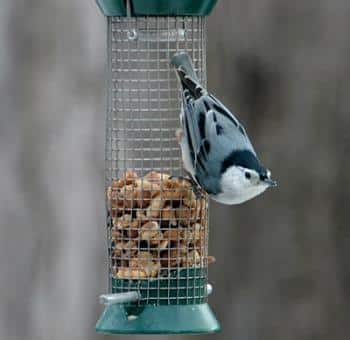Natty, Noisy Nuthatch

White-breasted Nuthatch
Photo Credit: Val Cunningham
by Val Cunningham
Contributing Writer
“Yank . . . yank . . .yankyank.”
Anyone out in the woods at this time of year has heard this distinctive nasal sound echoing through the trees. It’s the staying-in-contact call of the white-breasted nuthatch, a handsome gray, black and white, sparrow-sized bird. Male and female nuthatches, unlike most other birds, remain paired up throughout the year, and “yank” frequently to each other during feeding forays.
They’re little busybodies, spending much of each winter day industriously searching for food tidbits hidden away in the crevices in tree bark.
As a matter of fact, you can see and hear nuthatches right in your own backyard, if there are large, old deciduous trees around and feeders filled with seeds and suet. Nuthatches are inseparable from trees—sleeping and nesting in tree cavities and prowling tree trunks and limbs for food. A favorite treat is egg sacs carefully hidden by spiders and insects. The diligence of nuthatches (and other birds) in snapping up these high-protein snacks in fall and winter keeps our springtime from being overrun by these small creatures.
We humans seem to regard nuthatches as the clowns of the bird world, and much of this is due to their unique foraging style. Other birds hop up tree trunks, or flit from branch to branch or walk on the ground as they hunt for food. Nuthatches are different. They skitter down a tree, spiraling head first around the trunk, toes firmly planted and eyes darting. This different-from-other-birds feeding style has evolved to let them find food morsels other birds, who work a tree in the opposite direction, may have missed. Compare a nuthatch’s behavior to that of a downy woodpecker: the downy hops up and up the trunk, probing the bark as it rises.
Nut Hackers
Even their name is fun, and is very apt, since nuthatches do, indeed, hack open nuts with their strong bills (nut + hatch, from Middle English), first wedging them into bark or tree fork. And they’re very focused on stockpiling food for winter, scavenging either in the forest or at bird feeders. They’ll spend hours dashing to and fro, snatching one seed at a time to hide for later consumption in bark crevasses, stone walls or other sites. The shingles on the edge of my garage roof are slightly raised from all the safflower seeds hidden underneath by nuthatches.
These homebodies identify strongly with their territory and seldom leave it. Nuthatches will join a small, moving flock of chickadees and downy woodpeckers as they feed during the winter, but they drop out once the group reaches the edge of their territory.
They don’t like intruders, a fact I observed on a recent birding outing in a suburban park. A group of chickadees and nuthatches suddenly began “dee”-ing and “yank”-ing as they flew at a clump of leaves stuck in the fork of a tree, nervous behavior that is often a sign of a predator nearby. Sure enough, inside the leaf clump we spied one of the smallest and most beautiful of Minnesota’s owls, the tiny saw-whet, resting during the day before resuming its nighttime migration.
In our backyards, nuthatches relish feeders filled with shelled peanuts and suet, as well as black-oil sunflower and safflower seeds. For those with lots of patience and time, nuthatches can be trained to come to the hand to snatch a seed.
As winter progresses, keep an eye and ear out for these natty little birds, as they busily hoard seeds for tough times and noisily stay in touch with each other.
St. Paul, Minnesota resident Val Cunningham, leads bird hikes for the St. Paul Audubon Society and writes about nature for local, regional and national newspapers and magazines.



